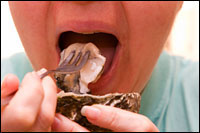I don’t know about you, but sometimes it just seems like more fun to have dinner with a group of friends — those who are single and those who aren’t — on Valentine’s Day than with just one person. Why? Well, let me put it this way: having dinner with just one person, no matter how beloved that person is, does not guarantee that your evening will be a romantic one.
Case in point: A few years ago I called a former beau to ask if he wanted to go out to dinner, as we were both single that year. After a nice dinner at an Indian restaurant (the perfect venue for couples in which one is a vegetarian and the other is not), we were heading home, and somehow got onto the topic of slugs having sex. He said that he had witnessed this phenomenon on a moonlit night. He saw two slugs attached to the banister on his porch stairs by long strings of spittle, engaging in a complex aerial lovemaking session in which they would curl around one another in various positions. Part of me was pleased that he was sharing something important to him, which he described as the most sensual thing he had ever seen. But at the same time, part of me was thinking, “I can’t believe I’m spending Valentine’s Day night listening to an ex-boyfriend talk about watching slugs get it on!”
Shortly thereafter, I told one of my friends about my unusual Valentine’s Day experience and he said, “I saw the same thing! It was a moonlit night … the slugs were hanging from a newel post… it was the most amazing thing I’ve ever seen!”
So this is why I recommend the dinner party approach. That way, if someone wants to talk slug sex or other esoterics, another friend might join in merrily. And think of the public service you will be performing! Friends who are unhappily single will have a place to go, friends who are in couples won’t feel compelled to go out to dinner at a pricey restaurant, and should you happen to invite two single people who might take an interest in one another, well … more karma points for you.
So what to serve at your table? For inspiration, we turn to the movies.
I recently saw two movies that would be perfect for a seafood-centric Valentine’s Day mini-movie-marathon: Next Stop Wonderland stars Hope Davis as a woman seeking her soulmate, who may or may not be a guy who’s a volunteer diver at the New England Aquarium. And the stupidly titled but otherwise very diverting Woman on Top stars Penelope Cruz as a chef from Brazil who gets her own cooking show in San Francisco. The movie has some fantastical elements, and there is a lot of emphasis put on how the health of the fishing stocks in the ocean near the woman’s restaurant in Brazil is dependent upon her and her husband falling back in love. Both movies feature beautiful Brazilian music.

So here’s a menu for a Valentine’s Day dinner for eight featuring a bevy of invertebrates. Oysters, of course, and scallops (because I myself am not crazy about oysters) and a shellfish stew made from shellfish that I was able to buy according to the wallet guide for New England. And of course, if you are suddenly beset by images of amorous slugs, you can always serve some garlicky escargot.
I would also serve a salad and either the cherry chocolate cake (I recently made up a white chocolate sauce with Kirsch to go with it, see the recipe below) or high-quality canned pears packed in their own juice with chocolate sauce spiked with pear juice from the can. You can use Poire William or Pear brandy to spike the chocolate sauce as well.
Appetizers
I would make either the bacon-wrapped scallops OR the “angels on horseback” (bacon-wrapped oysters), but not both. I made both when my friends and I were taste-testing these recipes and it was really too much food when served with the stew. Of course you could just make two scallops and two oysters for each person as an appetizer and that might be the nicest mix of all.
Scallops wrapped in bacon with maple syrup
Serves 8 as an appetizer (3 scallops each)
The idea of adding maple syrup may sound odd at first, but when you taste the end result you can’t tell that there is any syrup involved. Scallops are a symbol of those undertaking a pilgrimage, and are also revered as a fertility symbol in some cultures. Think of Botticelli’s “Birth of Venus” a.k.a. “Venus on the half-shell.”
12 pieces of thinly sliced bacon
24 sea scallops (medium to large size, not tiny bay scallops)
1/4 cup maple syrup (approximately)
- Turn on your oven’s broiler. Line a broiler pan with silver foil.
- Cut the pieces of bacon in half lengthwise to make 24 strips.
- Wrap one of the bacon strips firmly (yet gently) around each scallop. I find that you really don’t need to secure them with toothpicks. Place the scallops on the foil with the spot where the bacon overlaps facing down.
- Using a small spoon, spoon about 1/2 teaspoon of maple syrup over each bacon-wrapped scallop.
- Broil until the bacon begins to get a bit brown. Do not let the bacon char! (It chars faster because of the maple syrup; so keep an eye on it.) Once the top of the bacon has browned a bit, turn the scallops over using a pair of tongs. Keep them in the oven just until the bacon on the underside has cooked through.
Angels on horseback (bacon-wrapped oysters)
Serves 8
I was dismayed to discover, while shopping for my test meal, that it is no longer possible to buy shucked oysters in Massachusetts. You can eat shucked oysters while sitting at a raw bar, and you can buy oysters in the shell to take home, but no way no how can you take a shucked oyster home with you. After going to many, many stores I finally found some sealed containers of shucked oysters from Chesapeake Bay, and that’s what I used in the recipe. I hope that you are either feeling very skillful and empowered and are willing to shuck your own oysters or that you live someplace where you can get your hands on some oysters that have been shucked for you. If none of these things is available, I think oysters from a tin would do just fine.
This recipe is from Oysters: A Culinary Celebration by Joan Reardon, published by the Lyons Press. (Disclosure: I used to work for the literary agent who was the agent for this book.) It’s a wonderful and informative book full of oyster lore as well as recipes. If you find yourself wanting to read more about oysters, Mark Kurlansky’s book The Big Oyster: History on the Half Shell is a very good book about oysters and the role they played in the history of New York City.
According to Reardon’s book, these were traditionally served as after-dinner “savories” to prepare the palate for drinking port. Reardon recommends serving these with drinks before dinner, particularly a Pilsner or an Oregon Chardonnay.
24 shucked medium-sized oysters
1 cup dry white wine
1 minced garlic clove
Freshly ground pepper
12 slices bacon
24 buttered toast rounds (optional)
Oven temperature: high broil
- Drain the oysters and marinate them in wine, garlic, and pepper for one hour.
- Cut the bacon in half and cook in a microwave oven for 1 minute or pan-fry until the edges begin to curl but the bacon is still flexible. Drain well.
- Wrap each oyster in bacon and secure with a damp cocktail pick.
- Place the oysters on a broiler pan and broil on each side until the bacon is brown and crisp.
- Serve with the cocktail pick, or the pick can be removed and the oyster placed on a buttered toast round.
Main Course
Wallet Guide shellfish stew
Serves 8
The name of this recipe may make you think of that song lyric “first I look at the purse” but it really refers to the wallet guide to sound seafood choices. If you don’t want to put pepperoni in the stew, use crushed fennel seeds instead. Some mussels have “beards” which are little bits of tissue that protrude from the shell and which look sort of like threads made of steel wool. A good tug will pull them out of the mussel. Pay attention to see if the mussels and clams are shut tight before you rinse them. If they are not shut tight — or don’t shut tight when you touch them — toss ’em out!
1 cup olive oil
1 cup yellow onion, finely chopped
2 shallots, finely chopped
2 28 oz cans crushed or whole tomatoes (“fire roasted”, ideally)
1 clove garlic, finely minced
1 cup sliced fennel (slice the stalks like celery)
1 cup chopped pepperoni or 1 tsp crushed fennel seed
1 8 oz bottle clam juice
1 32 oz carton fish stock
16 clams, rinsed
2 lbs bag of mussels, rinsed and beards removed
16 scallops
1/2 to 3/4 cup pinot grigio
salt and pepper to taste
1/2 teaspoon fresh oregano or 1/4 teaspoon dried
1/4 cup basil leaves, sliced into ribbons
1/2 cup chopped flat leaf (Italian) parsley
8 pieces of sturdy whole grain or French bread, toasted
- Pour the olive oil into a large stockpot. Heat it over medium-high heat. Add the chopped onion and shallots and sauté until the onions and shallots are completely cooked through and translucent. They do not need to brown.
- Add the tomatoes, garlic and fennel. Cook for five minutes.
- Add the pepperoni or fennel seed, clam juice and fish stock. Cook five minutes.
- Add the clams, mussels, and scallops. Cook until the clams and mussels open.
- Add the pinot grigio. (Start by adding ½ cup and then taste. Add more if you like.)
- Add salt and pepper to taste.
- Add the oregano, basil, and parsley just a minute or two before serving and stir them into the stew.
- Put a slice of bread at the bottom of each bowl. Pour stew on top of the bread. Serve.
Dessert
White chocolate sauce with Kirsch
This is a rich and delicious sauce but it is not thick or heavy. Because it is served warm, its texture is rather thin. I think it works best to plate a slice of cake atop the sauce in a small bowl. This is a non-vegan sauce due to the heavy whipping cream.
2 cups organic heavy whipping cream
7 ounces bars top quality white chocolate (I used two 3.5 oz bars)
1 or 2 teaspoons Kirsch (a clear cherry brandy)
- Break the chocolate bars into pieces and place them in the top of a double boiler. Add the cream. Heat slowly until the chocolate has melted just enough to be stirred into the cream to create a smooth sauce.
- Add one teaspoon Kirsch. Taste and see if you want to add the second teaspoon. Add the second teaspoon if you want more of a Kirsch flavor.
Pears with pear-chocolate sauce
I also like to serve high-quality canned pears packed in their own juice with chocolate sauce and I just put a tablespoon or two of the juice from the can in the chocolate sauce. The combination of pear and chocolate is hard to beat. You could also substitute Poire William or Pear Brandy for the pear juice, but I like the simplicity and clarity of the delicious juice.

